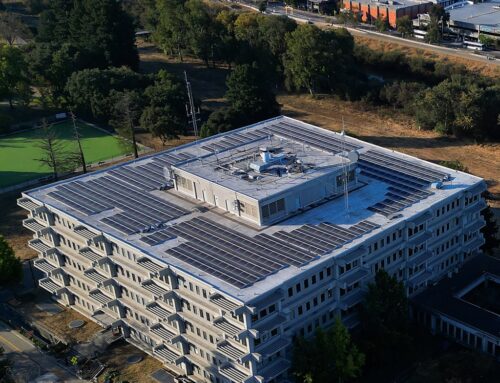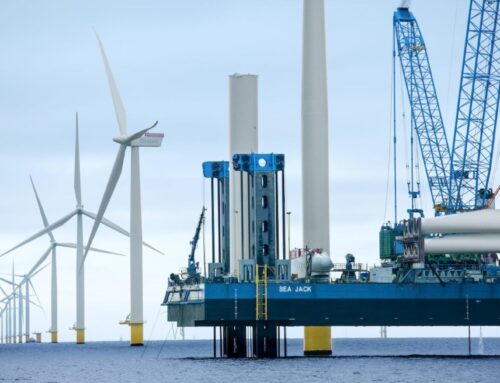How Fracking Technology Could Drive a Clean-Energy Boom
October 26, 2024
From our collaborating partner Living on Earth, public radio’s environmental news magazine, an interview by Paloma Beltran with Jamie Beard, the founder of Project InnerSpace, which aims to kickstart geothermal power generation.
Earth’s crust holds an abundant supply of heat that can be turned into electricity through geothermal technology.
So far, geothermal power generation has been mostly limited to volcanic areas like Iceland, where that heat is easy to access. But advances in deep drilling technology are revolutionizing the field worldwide.
In 2006, research led by MIT for the national labs pointed to the huge opportunity of this deep geothermal as an always-on renewable that some say could be a game-changer for the climate. And recently, the Interior Department greenlit the massive Fervo Energy project in Utah that should produce as much as 2 gigawatts, enough to power more than 2 million homes.
Jamie Beard is the founder of Project InnerSpace, which aims to kickstart geothermal with drilling expertise from oil and gas. This interview has been edited for length and clarity.
PALOMA BELTRAN: How would you describe the current state of geothermal energy in the United States?
JAMIE BEARD: The current state is really exciting. Geothermal has been pretty sleepy in the United States, and quite frankly, globally, because geothermal is limited geographically in where you can do it in the hydrothermal sense, but also just because there has not been a lot of awareness about geothermal and the opportunity that it presents. Because of that, there’s not been a whole lot of investment in the space. There’s not been a whole lot of interested parties who want to do projects.
That’s changing rapidly in the United States, where now we have a lot of stakeholders interested in developing geothermal projects. Technology companies are engaging in geothermal, wanting to produce geothermal energy to power data centers, and there’s also a lot of interest coming out of the oil and gas industry now in geothermal. We’ve entered this renaissance period in the United States and globally for geothermal.
BELTRAN: What would you see as the potential for geothermal in our energy landscape, especially when it comes to the idea of base load power?
BEARD: Most folks are aware when it comes to solar and wind that they’re intermittent. They’re not on all the time.

Geothermal doesn’t have that issue. Once you develop geothermal and build a power plant, it’s got a really high capacity factor, meaning how much it’s on, and it doesn’t really depend on when the sun is shining or when the wind is blowing—it’s just always there. You can even ramp it up and down, depending on energy demand at any given time.
That makes geothermal quite exciting when you look at critical infrastructure and needs like data centers that really depend on firm clean power, and need a lot of it to service their demand. Geothermal as a base load is a really exciting prospect. Geothermal as a heating and cooling application is also a really exciting prospect. There are a lot of really interesting areas to explore in geothermal development.
BELTRAN: Just to be clear, this is not your mother’s backyard geothermal used for home heating and cooling. How deep are we talking about here for the next generation of geothermal?
BEARD: If you are familiar with geothermal, you very well may be familiar with geothermal heating and cooling for houses, and that’s been around. A lot of folks have what they call shallow or direct-use geothermal heating and cooling systems, and those are great. We should absolutely grow that space, too. But that is not what we’re talking about when we’re talking about next-generation geothermal.
What we’re talking about is drilling for geothermal energy at depths at least as deep as we drill for oil and gas currently, 10,000 and 30,000-foot depths. Eventually, geothermal will need to advance to very deep, very hot resources if we want to keep advancing. But there is an enormous amount of developable geothermal energy at depths that we’re already used to drilling within the oil and gas industry. So let’s go get those first; that’s the low-hanging fruit that we need to aim for.
BELTRAN: Since this system involves deep drilling similar to the kind used in oil and gas extraction, what opportunities do you see for getting the fossil fuel industry on board with the clean energy transition?
BEARD: The single biggest opportunity that we have in geothermal right now is leveraging the capabilities, the technologies and the workforce of the oil and gas industry. Also, the global scale of the oil and gas industry.
As we look to moving fast in finding climate solutions and going fast in producing clean energy, the oil and gas industry very well may be the golden ticket to that, because they already have a highly skilled and trained workforce that knows how to drill. It’s just a matter of turning a lot of that workforce and energy and technologies that are coming out of the oil and gas industry to drilling for heat instead of drilling for oil and gas. So, massive opportunity; quite frankly, it’s mind blowing.
Geothermal is currently sitting at 1% in estimates for global energy demand. But if the oil and gas industry were to throw in on geothermal and really engage and we started drilling geothermal wells at the rate that we currently drill for oil and gas wells, that’s about 70,000 wells globally for oil and gas right now. If we were to do that for geothermal between now and say, 2050, geothermal could supply almost 80% of the world’s electricity demand and more than 100% of the world’s heat demand. That’s huge. It’s a massive potential impact, but that impact is 100% reliant on the oil and gas industry really helping grow and scale the technology over the coming decades.
This story is funded by readers like you.
Our nonprofit newsroom provides award-winning climate coverage free of charge and advertising. We rely on donations from readers like you to keep going. Please donate now to support our work.
BELTRAN: For people who are not familiar with geothermal technology, does it involve fossil fuels?
BEARD: With any energy technology, when you’re drilling or building a power plant or manufacturing, you’re going to use energy to build that plant or to produce that energy project. So unless we electrify everything, geothermal will probably produce some carbon emissions, because we’re going to have to build the plants.
But geothermal, once it’s developed and once it’s producing power, it’s using the heat that’s in the Earth to produce clean electricity and clean heat. In that way, it’s a virtually carbon-free clean energy source.
Now, some next-generation geothermal concepts actually adopt hydraulic fracturing, or fracking technology, from the oil and gas industry. It’s a technique where you’re applying pressure to a well to essentially make more space in the rock. You’re cracking rocks open to make pore space in them. And if you’re taking that technology from the oil and gas industry and transferring it into geothermal, you’re leaving the oil and gas part behind and just using the technology to help the geothermal system work better.
BELTRAN: What makes you confident we can scale up this technology?
BEARD: My answer would be the shale boom. If folks remember 15 or so years ago when … the natural gas boom—what the oil and gas industry calls “unconventionals”—had not happened yet and folks were talking about how we had reached peak oil and peak gas, it was all downhill from here.
And then all of the sudden, within a decade, what we call colloquially the shale boom occurred—a massive flourish of technological development, massive advances in the oil field and in natural gas production techniques. We went from talking about peak oil and peak gas to the U.S. becoming the world’s leading natural gas and oil producer in the world. That happened within a decade.
If we look at that transformation—massive geopolitical transformation within a decade in the energy landscape—and we look at the capabilities of the oil and gas industry to transfer all of that energy and speed into geothermal, that’s a really exciting prospect. We’re talking about the next shale boom, but it’s not gas and it’s not oil, it’s geothermal. We’ve done it before. We can do it again.
About This Story
Perhaps you noticed: This story, like all the news we publish, is free to read. That’s because Inside Climate News is a 501c3 nonprofit organization. We do not charge a subscription fee, lock our news behind a paywall, or clutter our website with ads. We make our news on climate and the environment freely available to you and anyone who wants it.
That’s not all. We also share our news for free with scores of other media organizations around the country. Many of them can’t afford to do environmental journalism of their own. We’ve built bureaus from coast to coast to report local stories, collaborate with local newsrooms and co-publish articles so that this vital work is shared as widely as possible.
Two of us launched ICN in 2007. Six years later we earned a Pulitzer Prize for National Reporting, and now we run the oldest and largest dedicated climate newsroom in the nation. We tell the story in all its complexity. We hold polluters accountable. We expose environmental injustice. We debunk misinformation. We scrutinize solutions and inspire action.
Donations from readers like you fund every aspect of what we do. If you don’t already, will you support our ongoing work, our reporting on the biggest crisis facing our planet, and help us reach even more readers in more places?
Please take a moment to make a tax-deductible donation. Every one of them makes a difference.
Thank you,
Search
RECENT PRESS RELEASES
Related Post




